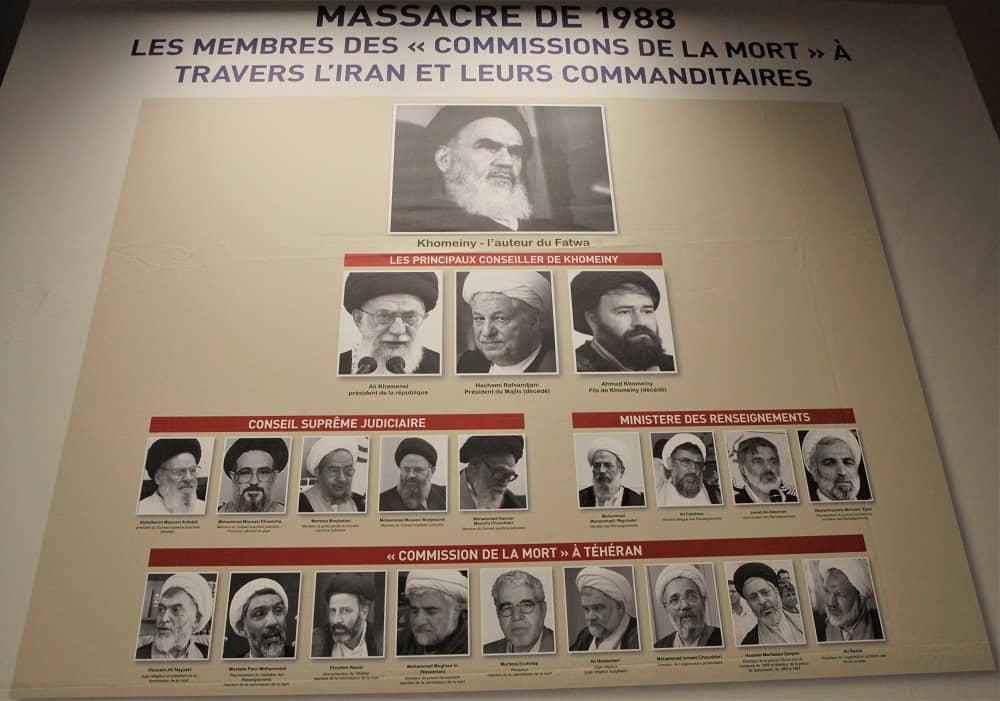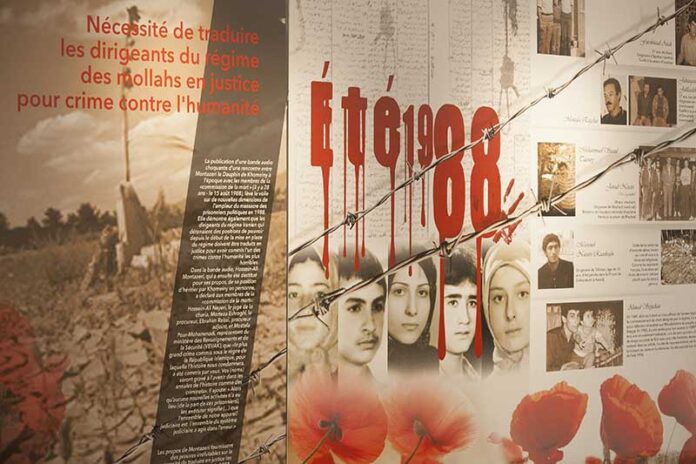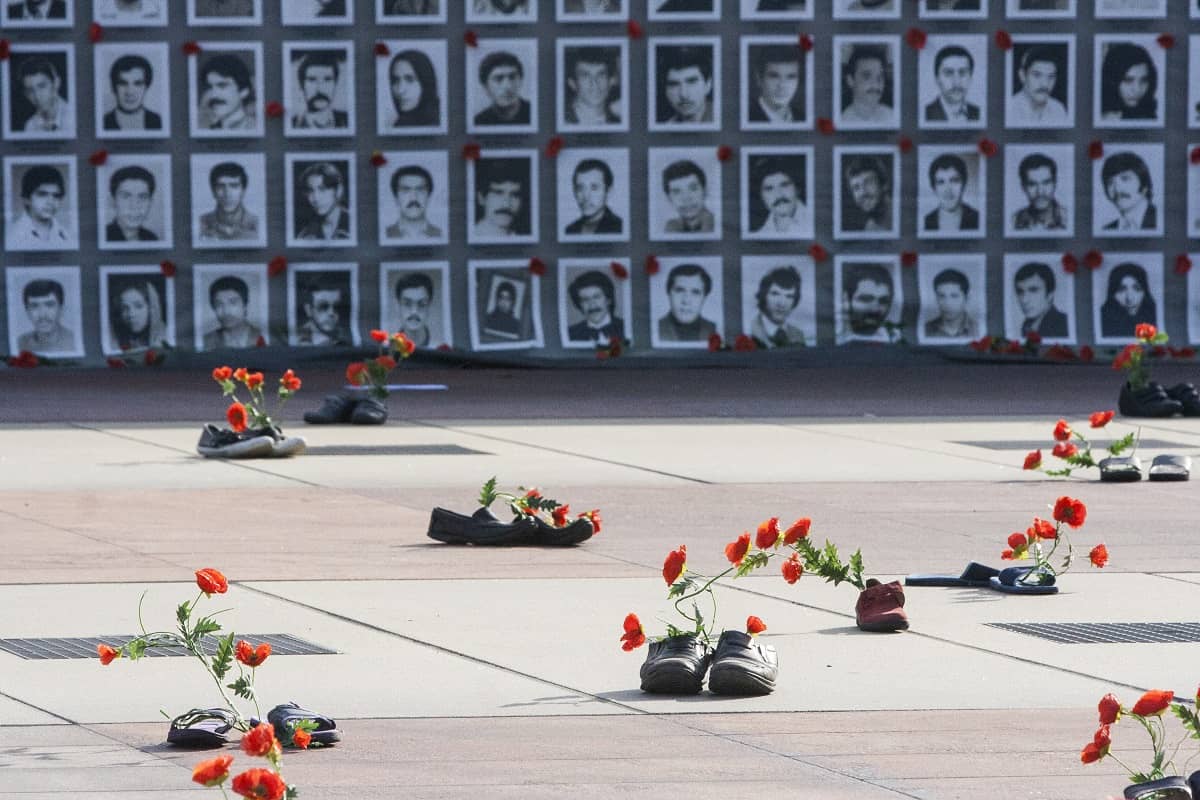Montazeri to Tehran Prosecutor Lajevardi: “You go and kill people in the streets… You murder them and then blame the MEK in order to discredit them in the eyes of the public and to justify their executions.”
On December 20, 2021, Mehr News Agency, affiliated with the Iranian regime’s Ministry of Intelligence and Security (MOIS), published an extensive interview about the former No. 2 official of Iran’s ruling theocracy, Ayatollah Hossein-Ali Montazeri. In 1985, Montazeri was officially designated as the successor to the regime’s founder Ruhollah Khomeini. But in 1989, before Khomeini died, Montazeri was unceremoniously stripped of the title, publicly ostracized, and eventually placed under house arrest until he died in 2009.
The regime’s “red line”: MEK
In the lengthy interview, an anonymous senior Intelligence Ministry official explains the trajectory of Montazeri’s post-1979 revolution politics, focusing specifically on developments concerning the main opposition Mojahedin-e Khalq (MEK). The intelligence official begins by describing Montazeri as a former student of Khomeini and his “designated representative with full authority.” He then outlines how Khomeini and his inner circle became wary of developments in Montazeri’s office (Beyt), ultimately forcing Khomeini to dismiss Montazeri of all his official titles, particularly after the latter protested the 1988 massacre of 30,000 political prisoners, the vast majority of whom belonged the MEK.
Hamid Noury, one of the perpetrators of the 1988 massacre in the notorious Evin and Gohardasht prisons, has been on trial in a court in Stockholm since August 10, 2021. The prosecutors have charged him with committing war crimes and murder when a deputy prosecutor in Gohardasht. Many experts believe these atrocities amount to genocide.
During the proceedings in November, Noury testified on his own behalf, insisting that he did not want to refer to the MEK by its official name because even uttering the MEK’s name would result in him being prosecuted and convicted in Iran. His testimony further highlighted the reality that the MEK, or even its name, has been one of the most critical red lines for the regime, and anyone believed to legitimize or support the MEK remotely is treated harshly. Montazeri, the regime’s No. 2, was not an exception.
A good deal of the Mehr interview focuses extensively on Montazeri’s stance toward the MEK. The intelligence official says that in 1983, Khomeini had warned regime authorities that “criminals” (i.e., opponents) “seek to exploit you personally and will want to infiltrate your offices … to cause deviations within the system (regime).” Within this context, regime authorities grew weary of the political influence of the MEK, not just within society at large but also potential “infiltration” into the offices of top authorities. Khomeini ordered the newly created Intelligence Ministry to pay particular attention to the activities of Montazeri’s office. The intelligence official said even before the Revolution, some in Montazeri’s office, including his son-in-law, had sympathized with the MEK and its cause.
Regime terrified of the MEK’s popularity and social base
The official claims: “Mr. Montazeri’s stance gradually shifted to supporting the MEK. Initially, he criticized the methods and how the state dealt with the MEK, and year after year, the intensity of support for the MEK increased until we reached 1988 when he openly took a stance against the Imam (Khomeini) and the state while supporting the MEK.”
Inadvertently underscoring the MEK’s extensive social base, the official admits that many families of those imprisoned for sympathizing with the MEK met with Montazeri and had an opportunity to voice their grievances and the crimes committed against them.
“It is this trend that causes Mr. Montazeri in 1988 to defend the MEK against the Imam (Khomeini) and the state.” In 1988, through a hand-written religious decree that Montazeri later published in his memoir, Khomeini ordered annihilating all MEK supporters in prisons across Iran. Subsequently, in the span of a few months, the regime executed some 30,000 political prisoners, over 90% of whom were members of the MEK.
The intelligence official makes another startling revelation, saying that as early as 1983, Khomeini had ordered its subordinates to “uproot them (MEK) before I die.” This unearths how the MEK’s growing popularity mortified Khomeini, fueled by a hysteric ideological animosity toward the movement. It also makes it abundantly clear that Khomeini had intended to conduct an unprecedented genocide against the MEK since the beginning of his rule, a plan that culminated in the 1988 massacre.

Disinformation against the MEK to justify their murder
In another revelation, the intelligence official recounts a series of meetings in 1983. He says that Montazeri was critical of the Prosecutor’s Office’s brutality towards MEK activists, particularly the chief Tehran prosecutor Assadollah Lajevardi. Against this backdrop, Lajevardi, Islamic revolutionary court judge Mohammadi Gilani, and chief prosecutor Moussavi Tabrizi traveled to Qom to meet with Montazeri. Montazeri said: “I have known Lajevardi since before the Revolution. He opposed and was hostile to the MEK even then.”
According to the intelligence official, Montazeri went on to say: “You [regime officials] go and kill people in the streets, people who, for example, post a picture of the Imam in their shops or have long beards. You murder them and then blame the MEK in order to discredit them in the eyes of the public and to justify their executions.” The intelligence official adds that Montazeri said this with conviction and based on reliable information. When these officials went back to Khomeini to complain about Montazeri’s comments, Khomeini told them: “Go continue your work; uproot them [the MEK] before I die.” Khomeini was hell-bent on eliminating the MEK from day one.
The remarks attributed by Montazeri that he told Lajevardi that the regime killed ordinary people and blamed it on the MEK is quite telling, particularly because it comes from a man who was no friend of the MEK.
After the fall of the Shah in 1979, the MEK became Iran’s largest political party with support among virtually every stratum of society. So extensive was this social support that it penetrated even quarters within the regime that were growing critical of authoritarian policies. The events of the early 1980s and Montazeri’s conflict with Khomeini over the execution of the MEK show that the organization is very much part of the fabric of the Iranian society, going back to the Shah’s years. Judging by the intelligence agent’s admission, terrified of the MEK’s popularity, the regime did its utmost, including the murder of ordinary citizens, and blamed it on the MEK in an attempt to demonize the MEK.
The 1988 genocide
On August 15, 1988, Montazeri met with members of the Death Commission in Tehran, who were responsible for implementing Khomeini’s orders to eradicate all MEK political prisoners who remained steadfast in their loyalty to the group. Among the members was Tehran’s current president Ebrahim Raisi. Montazeri’s son leaked the audiotape of the meeting in August 2016. Montazeri lambasts the Death Committee members for massacring political prisoners in the meeting. He told the Death Committee members: “In my opinion, the greatest crime committed under the Islamic Republic, from the beginning of the Revolution until now, is this crime committed by you… Your (names) will in the future be etched in the annals of history as criminals.”
Montazeri went on to outline some of the crimes committed by the regime, saying: “In Isfahan, they executed a pregnant woman…. [In clerical jurisprudence] one must not execute a woman even if she is a mohareb (enemy of God). I reminded [Khomeini] of this, but he said they must be executed.”
Montazeri is heard telling members of the Death Commission that the Ministry of Intelligence had planned to carry out mass killings several years before. “Haj Ahmad, Mr. Khomeini’s son,” he said, “has been saying for three or four years, ‘The Mojahedin, even the ones who read their newspaper, to the ones who read their magazine, to the ones who read their statements – all of them must be executed.’”
According to Amnesty International’s 2018 report, Blood-Soaked Secrets, “Many survivors believe that the mass executions of 1988 were planned long before the armed incursion of the PMOI [MEK] on July 25, 1988.” The report also says that MEK carried out targeted military operations, meaning they did not strike at civilians.
Conclusion
The preceding confirms the indisputable fact that from the very first day after the anti-Monarchic Revolution in 1979, the battle lines were drawn between two rival political currents: The ruling clerics and the MEK. The former espousing a retrogressive and dogmatic interpretation of Islam, designed to justify its power grab, and the latter promoting a democratic, tolerant, and open-minded approach, with which most Iranians identified. This underlying battle of ideas sheds light on the reasons for the mullahs’ ruthless and uncompromising approach to the MEK and explains why this inconceivable brutality failed to eliminate the MEK and its roots in society. Montazeri’s remarks in his fateful August meeting with the “Death Commission” members confirm this. “Ultimately, the Mujahedin-e Khalq are not simply individuals. They represent an ideology and a school of thought. They represent a line of logic. One must respond to the wrong logic by presenting the right logic. One cannot resolve this through killing; killing will only propagate and spread it,” Montazeri had emphasized.






